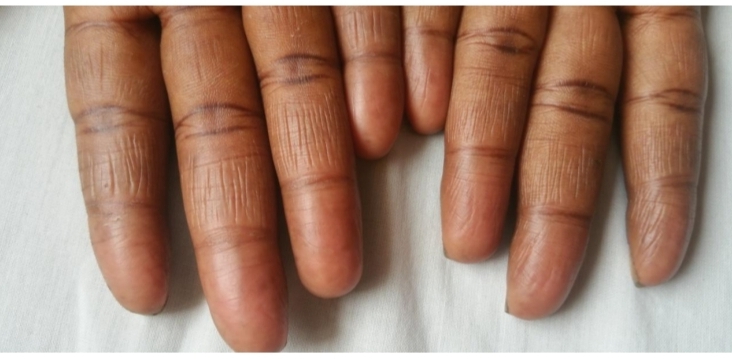Every human being has unique epidermal ridges on the palms including fingers which enable us to fingerprint. Fingerprinting is now a commonly utilized method of identifying individuals because of the uniqueness. What happens when you don’t have any unique fingerprint to be identified with due to an absence of these ridges on your fingers?
Yes, you heard that right. Some people are unable to fingerprint because they were either born without these ridges on their fingers (congenital adermatoglyphia) or they developed it later in life (acquired adermatoglyphia). The congenital one may be inherited alone or as part of a syndrome where you may have abnormalities in the hair, skin and nails. It is an uncommon condition.
The acquired one may be caused by conditions such as allergic or irritant contact dermatitis (which I have written about before here)
Let’s talk about hand dermatitis
leprosy, fungal infections, some drugs like retapamulin, atorvastatin, prolonged use of topically applied steroids amongst others.
Did you know that this condition is also called Immigration delay disease? We all know fingerprinting is a common mode of identification at the airport and even when you need to get your passport or write some exams.
The patient that prompted me to write this had an acquired form of adermatoglyphia and the poor girl had missed her exams twice because of this. It wasn’t until she got to us that she found a way out and she had to get a comprehensive medical report to cover for this.
Is adermatoglyphia curable? For most cases of the congenital ones – No.
In the acquired ones, the ridges may return after some time although the timing is not predictable.
The management of adermatoglyphia is to leave alone and ensure good care of the hands (moisturize liberally) if there are no other areas of the body involved (e.g if it is part of a syndrome).
For the acquired ones, manage the underlying cause if possible.
For all cases of adermatoglyphia, speak to your doctor to write you a comprehensive medical report to explain the condition so you can present this report in places where you need fingerprinting as part of identification. Other forms of identification such as using iris scanners may be employed.
My patient is happy now because she has gotten a diagnosis and a detailed report about her medical condition.
So, there you have it. Now you know about adermatoglyphia aka Immigration delay disease.
Any questions, comments or clarifications?
Featured image from Dieprebi, A. A., Dasetima, D. A., Bolaji, O.-O., & Belema, A. (2020). Adermatoglyphia: Challenges and Prospects in Diagnosis. Asian Journal of Research in Dermatological Science, 3(1), 30-39.


Hi to all, how is everything, I think every one is getting more
from this website, and your views are fastidious in support of new viewers.
Thank you so much! Do stop by again soon. You can subscribe so you know when there’s a new post.
Good respond in return of this question with firm arguments and
telling all on the topic of that.
This site really has all of the information I wanted
concerning this subject and didn’t know who to ask.
Thank you so much for reading and stopping by. Do stop by again soon. And I’ll keep writing!
Its like you read my mind! You seem to know so much about this, like you
wrote the book in it or something. I think that you can do with some pics to drive the message home a little bit, but other than that, this is wonderful blog.
A fantastic read. I will definitely be back.
Hi there would you mind letting me know which web host you’re working with?
I’ve loaded your blog in 3 completely different
web browsers and I must say this blog loads a lot quicker
then most. Can you recommend a good web hosting provider at a fair price?
Thanks, I appreciate it!
I use Bluehost. Did some research and saw that it had great reviews so I settled for it. Thank you!
Hey, I think your blog might be having browser compatibility issues.
When I look at your blog in Opera, it looks fine but when opening in Internet Explorer,
it has some overlapping. I just wanted to give you a quick heads up!
Other then that, very good blog!
Thank you so much for bringing this up. Working on it. Do stop by again soon.
You can soak your fingers in line or lemon for some hours and your prints will become visible if their disappearance was due to harsh work or environment conditions
I have seen patient develop irritant dermatitis (which is the point of using) to see if the markings will return. Sadly, several had to deal with the irritant dermatitis and yet the finger prints did not get restored. Easy on this